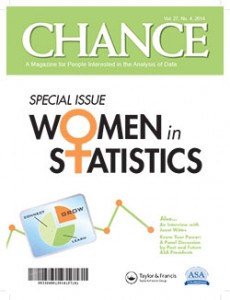Special Issue Devoted to Women in Statistics
Scott Evans, CHANCE Executive Editor
Years ago, women were discouraged from engaging in the mathematical sciences. Women also faced prevalent issues of salary discrimination and a lack of maternity leave alternatives in the workplace. Fortunately, times are changing. There is a refreshing evolution of attitudes about women in science, one that welcomes young women into promising fields and recognizes their contributions. In 2014, Maryam Mirzakhani became the first woman to be awarded the Fields Medal, often termed the “Nobel Prize of Mathematics”!
Statistics, in particular, has become a promising field for women. In the October 2013 issue of Amstat News, ASA Director of Science Policy Steve Pierson summarized data from a report issued by the National Center for Education Statistics (NCES) regarding degrees in statistics granted in 2012. More than 40% of statistics degrees go to women, a much larger percentage relative to other science fields. Nearly 50% of master’s degrees go to women. For 2011 and 2012 combined, 57% of master’s degrees in biostatistics went to women (740 total biostatistics degrees over the two years) and 55% of PhDs went to women (298 total degrees).
This special issue of CHANCE is devoted to recognizing and celebrating women in statistics and their contributions to statistical science. Many of the articles were born from the Women in Statistics Conference, held May 15–17, 2014, in North Carolina. Organizers included the ASA Committee on Women in Statistics and the Caucus for Women in Statistics. The Conference highlighted the achievements and career interests of women in statistics. Special sessions focused on career development, the work of leading researchers, and opportunities and perspectives on the role of women in today’s statistical fields. Dalene Stangl not only helped organize the conference, but also organized the plan for this special issue. Other contributers include Stephanie Hicks, Kimberly Sellers, K. Nicole Meyer, Maria Terres, Samantha Tyner, Kaitlin Woo, Stacy Lindborg, Arati Mejdal, Joanne Wendelberger, Alyson Wilson, Sandra Stinnett, Brenda Gaydos, Jane Harvill, Kristen Tecson, Karen Kafadar, Snehalata Huzurbazar, Jessi Cisewski, Bailey Fosdick, and Xia Wang.
Also featured in this issue is an interview with Janet Wittes, founder and president of Statistics Collaborative, Inc. Janet is a past president of the Society for Clinical Trials and Eastern North American Region of the International Biometric Society. In 2006, she received the Janet L. Norwood Award for outstanding achievement by a woman in the statistical sciences. In this interview, Janet talks about the challenges of being a woman pursuing an education and developing a career in statistics in the 1960s. She also discusses clinical trials, the Women’s Health Initiative, and the future of women in statistics.
Elsewhere in this issue, Di Cook shows us how the gender gap in math is not universal in Visiphilia; Shannon McClintock Pileggi, Mine Cetinkaya-Rundel, and Dalene Stangl discuss a classroom project for generation Z in Taking a Chance in the Classroom; Rasmus Bååth and Christian Robert review all the cartoon books about statistics; and Howard Wainer discusses the causes and consequences to happiness in Visual Revelations.


















